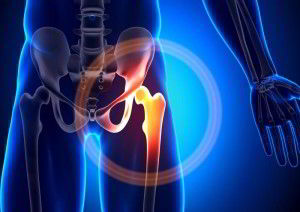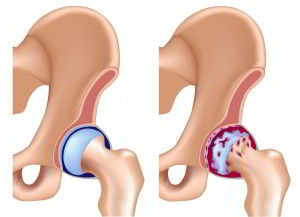Hip arthritis develops due to bacteria or viruses that penetrate the joint tissues. During the disease, the joint cavity of the membrane becomes inflamed. With the advanced stage, all articular cartilage and bones begin to suffer.
Symptoms of the disease
Arthritis of the hip joint has symptoms similar to those of the inflammatory process: the joints begin to hurt, the joints turn red and swell, the temperature rises, and the patient can hardly move.
Since the hip joint is the largest joint, when it is inflamed, the patient suffers from fever, weakness, malaise, headache and decreased appetite.
Symptoms depend on the nature of the disease:
- In the acute and subacute form, pain suddenly appears, swelling and mobility are impaired. After a while, the acute variant of the disease turns into a chronic form;
- In the chronic form, the symptoms of the disease worsen or subside. After some time, irreversible changes begin to develop, which can lead to complete immobility of the limb.
Arthritis of the hip joint is divided into 4 types, which have different symptoms of manifestation:
- With rheumatoid disease, the patient feels stiff in the joint in the morning, pain and swelling in the affected areas. The joints are affected symmetrically. In addition, internal organs can also suffer in parallel;
- Purulent arthritis is characterized by symptoms in the form of general weakness, fever, and excessive sweating. During movement, the pain becomes stronger and stronger. The joint becomes reddish-purple and swollen;
- In gouty hip arthritis, the affected tissues turn red, become hot, and joint mobility is impaired. Severe pain accompanies the patient for 10 days;
- With psoriatic hip arthritis, the skin becomes blue. Very often, psoriasis affects the vertebral sections.

Why joint disease develops
Causes of arthritis of infectious origin: the development of purulent arthritis or specific infections.
Inflammatory arthritis appears against the background of allergic reactions, aggression of one’s own immunity, and oncology diseases.
Causes of arthritis of the hip joint:
- Infection of the body with meningococcal infection, Lyme disease, tuberculosis, brucellosis and other diseases;
- They provoke illness and allergies, ankylosing spondylitis and Crohn’s disease;
- Intestinal diseases.
What is periarthritis?
Periarthritis is a dystrophic or inflammatory disease of the places of attachment of tendons to the bones and serous bags that are around the joints. The disease develops due to pathological changes in the periarticular tissues.

Hip joint periarthritis has many different symptoms that make it difficult to diagnose the disease and determine the exact cause of its occurrence. This disease most often makes itself felt to people of retirement age.
Periarthritis has the following symptoms:
- When pressing on the hip joint, the patient feels a sharp pain;
- It is difficult for the patient to move independently, he begins to limp;
- A swelling appears in the affected joint.
Causes of periarthritis:
- Infectious diseases;
- Age-related changes in the body;
- Diseases of the hip apparatus;
- Spending a lot of time in the cold;
- Weakened immunity.
Periarthritis most often affects men than women between the ages of forty and fifty-five.
In order to diagnose periarthritis, it is important to take all the necessary tests, examine the synovial fluid and synovial membrane, and conduct an X-ray examination of the joints. It is also useful to do an x-ray.
Treatment of the disease recommends limiting physical activity, taking drugs that relieve inflammation.
Hip joint periarthritis is treated with thermotherapy, physiotherapy, injection of novocaine solution, treatment in a sanatorium, as well as radiation therapy.
Children’s Hip Arthritis
Arthritis of the hip joint in children is very common. The age characteristics of the child, the state of his immune system and the high sensitivity of the body affect the development of childhood arthritis. The disease proceeds in an acute form, has severe symptoms of local and general inflammation.
Purulent arthritis is considered very dangerous for the child, since if you do not determine it in time and start treatment, you can lose a small patient.
An infectious form of arthritis in children can develop due to mumps, meningococcal infection, chickenpox, rubella, measles, intestinal infections, or SARS.
There are also situations of arthritis due to the reaction of the child’s body to vaccinations. If timely in this case, anti-allergic treatment is carried out, the symptoms of arthritis will disappear very quickly.
An important point! If the disease of the hip joint in children is caused by other diseases, antipyretic drugs will not allow all the symptoms of the disease to manifest. If it is difficult for a child to step on his foot, he cannot walk, stumbles and falls – urgently consult a doctor to rule out arthritis.
First aid
To relieve severe pain and reduce fever, the doctor may advise you to drink Ortofen, Ibuprofen, Nise or another non-steroidal anti-inflammatory drug. The listed remedies reduce pain and relieve inflammation.
Children can be given Nurofen or Nise in a special children’s dose in the form of a suspension.
It is also important to keep the affected joint in a calm position. It is forbidden to load or “develop” a sick hip joint.
We treat arthritis correctly
Before starting treatment for arthritis, it is important to identify the cause of the disease. Only after this, the doctor prescribes an anti-allergic, immune drug, antibiotic, or drugs that affect the metabolism.
All types of arthritis are treated with non-steroidal anti-inflammatory drugs. If there is no use for such treatment, glucocorticoid hormones are used, which sometimes doctors are forced to enter into the joint cavity itself.
The acute purulent form of arthritis is treated only surgically. A puncture of the joint cavity is performed, and antibiotics with antiseptics are administered. If such treatment is also not effective, the specialist resorts to prolonged active or flowing drainage of the joint.
As soon as acute inflammation is removed, a treatment is prescribed that stimulates the normal mobility of the joint. To this end, it is important to engage in physical therapy, massage and physiotherapy. To make the treatment effect better, you can turn to alternative medicine methods (various tinctures, ointments, compresses or decoctions).
It is important at the first symptoms of the disease to consult a doctor for advice in order to establish an accurate diagnosis and timely proceed with the correct and effective treatment.



